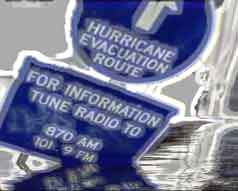Hurricane Season Runs From June 1 - November
30.
Last year's hurricane season blew away the predictions. Here's what a leading forecaster from Colorado State University says:
· This season will be busy, but not
as intense as last year.
· There's a 81 percent chance a major
hurricane could hit along the U.S. coast
and a 64 percent chance one could hit the
East Coast.
· The still-recovering Gulf Coast
could be hit again -- there's a 47 percent
chance of a major hurricane striking there.
Hurricane
Names 2006
Atlantic Hurricane & Tropical Storm
Names
| 2006 Hurricane Names | 2007 Hurricane Names |
|
|
| 2008 Hurricane Names | 2009 Hurricane Names |
|
|
For every year, there is a pre-approved list of names for tropical storms and hurricanes. These lists have been generated by the National Hurricane Center since 1953. At first, the lists consisted of only female names; however, since 1979, the lists alternate between male and female.
Hurricanes are named alphabetically from the list in chronological order. Thus the first tropical storm or hurricane of the year has a name that begins with "A" and the second is given the name that begins with "B." The lists contain names that begin from A to W, but exclude names that begin with a "Q" or "U."
There are six lists that continue to rotate.
Hurricane
Season 2006
Be prepared for this year's
hurricane season.
Find states' emergency info, and where to get help for Louisiana, Mississippi , Texas, Florida, Alabama, South Caraolina, North Carolina.
|
|
Five Hurricane
Names to Be Retired
DENNIS, KATRINA, RITA, STAN AND WILMA "RETIRED"
FROM LIST OF STORM NAMES
International Committee Selects Replacement
Names for 2011 List
April 6, 2006 — Hurricanes Dennis, Katrina, Rita, Stan and Wilma, all from the historic 2005 Atlantic hurricane season, were "retired" by an international hurricane committee of the World Meteorological Organization, which includes the NOAA National Hurricane Center, during their annual meeting in San Juan, Puerto Rico. Now retired, these five storms, part of last season's record-setting 27 named storms and 15 hurricanes, will not reappear on the list of potential storm names that is otherwise recycled every six years. (Click NOAA illustration for larger view of Hurricanes Dennis, Katrina, Rita and Wilma. Click here for high resolution version. Please credit “NOAA.”)
Dennis, Katrina, Rita, Stan and Wilma represent the type of devastating storm that is "retired" for causing a large loss of life and property. These names will not be used again for sensitivity reasons and to establish distinction within the scientific and legal communities.
For 2011, Dennis, Katrina, Rita, Stan and Wilma have been replaced with Don, Katia, Rina, Sean and Whitney, respectively.
Since tropical cyclones were first named in 1953, 67 names have been retired (the first being Carol and Hazel in 1954), and with a total of five, 2005 has the most retired storm names in a single season (previous record: four in 1955, 1995 and 2004).
A synopsis of the newly retired storms:
Dennis began its path of destruction in
early July while passing between Jamaica
and Haiti and then crossing Cuba with estimated
top winds of 140 mph. After tracking north
across the eastern Gulf of Mexico, Dennis
came ashore on Santa Rosa Island, Fla.,
as a Category 3 hurricane on July 10 with
top winds estimated at 120 mph. At least
54 deaths are directly or indirectly attributed
to Dennis, including 15 in the U.S, most
from within Florida.
Katrina became the costliest and one of
the deadliest hurricanes in U.S. history
with damage costs exceeding $50 billion
and fatalities, directly and indirectly,
topping 1,300. Katrina came ashore at Buras,
La., as a Category 3 hurricane on August
29 with top winds estimated at 125 mph.
Additionally, Katrina was a Category 1 hurricane
when it first struck the U.S. near the Broward/Miami-Dade
County line in Florida on August 24 after
bringing tropical storm conditions to the
northern Bahamas.
Rita made landfall in extreme southwestern
Louisiana, near the Texas border, as a Category
3 hurricane with top winds of 115 mph on
September 24. Rita reached Category 5 strength
with top winds estimated at 180 mph over
the central Gulf of Mexico, where it had
the fourth-lowest central pressure on record
(895 millibars) in the Atlantic Basin. Rita
produced a significant storm surge that
devastated coastal communities in southwestern
Louisiana, and its wind, rain, and tornadoes
caused fatalities and a wide swath of damage
from eastern Texas to Alabama. Rita also
produced storm surge flooding in parts of
the Florida Keys as the storm's center passed
between the Keys and Cuba en route to the
Gulf Coast.
Stan, in combination with other weather
features, produced torrential rainfall in
Mexico and Central America where the combined
death toll is estimated to be as high as
2,000. Stan first crossed Mexico's Yucatan
Peninsula as a tropical storm, then moved
southwest across the Bay of Campeche and
hit as a Category 1 hurricane about 90 miles
southeast of Veracruz, Mexico, on October
4.
Wilma was an extremely intense Category
5 hurricane over the northwestern Caribbean
Sea with estimated tops winds of 185 mph
and the all-time lowest central pressure
(882 millibars) for an Atlantic Basin hurricane.
A slow-moving Wilma devastated coastal areas
of the northeastern Yucatan Peninsula of
Mexico as a Category 4 hurricane. It later
raced into South Florida—coming ashore
near Cape Romano, Fla., at Category 3 intensity
with top winds estimated at 120 mph on October
24—and inflicting extensive damage.
Names for the upcoming 2006 season, which
begins June 1, include Alberto, Beryl, Chris,
Debby, Ernesto, Florence, Gordon, Helene,
Isaac, Joyce, Kirk, Leslie, Michael, Nadine,
Oscar, Patty, Rafael, Sandy, Tony, Valerie,
William. On this list Kirk replaces Keith,
which was retired following its impact on
Mexico and Belize in 2000.
NOAA, an agency of the U.S. Department of Commerce, is dedicated to enhancing economic security and national safety through the prediction and research of weather and climate-related events and providing environmental stewardship of the nation's coastal and marine resources.
Through the emerging Global Earth Observation System of Systems (GEOSS), NOAA is working with its federal partners, 61 countries and the European Commission to develop a global network that is as integrated as the planet it observes, predicts and protects.
Worldwide
Tropical Cyclone Names
Reason to Name Hurricanes
Experience shows that the use of short,
distinctive names in written as well as
spoken communications is quicker and less
subject to error than the older, more cumbersome
latitude-longitude identification methods.
These advantages are especially important
in exchanging detailed storm information
between hundreds of widely scattered stations,
coastal bases, and ships at sea.
The use of easily remembered names greatly
reduces confusion when two or more tropical
storms occur at the same time. For example,
one hurricane can be moving slowly westward
in the Gulf of Mexico, while at exactly
the same time another hurricane can be moving
rapidly northward along the Atlantic coast.
In the past, confusion and false rumors
have arisen when storm advisories broadcast
from radio stations were mistaken for warnings
concerning an entirely different storm located
hundreds of miles away.
History of Hurricane Names
For several hundred years many hurricanes
in the West Indies were named after the
particular saint's day on which the hurricane
occurred. Ivan R. Tannehill describes in
his book "Hurricanes" the major
tropical storms of recorded history and
mentions many hurricanes named after saints.
For example, there was "Hurricane Santa
Ana" which struck Puerto Rico with
exceptional violence on July 26, 1825, and
"San Felipe" (the first) and "San
Felipe" (the second) which hit Puerto
Rico on September 13 in both 1876 and 1928.
Tannehill also tells of Clement Wragge, an Australian meteorologist who began giving women's names to tropical storms before the end of the l9th century.
An early example of the use of a woman's name for a storm was in the novel "Storm" by George R. Stewart, published by Random House in 1941, and since filmed by Walt Disney. During World War II this practice became widespread in weather map discussions among forecasters, especially Air Force and Navy meteorologists who plotted the movements of storms over the wide expanses of the Pacific Ocean.
In 1953, the United States abandoned a confusing two-year old plan to name storms by a phonetic alphabet (Able, Baker, Charlie) when a new, international phonetic alphabet was introduced. That year, the United States began using female names for storms.
The practice of naming hurricanes solely after women came to an end in 1978 when men's and women's names were included in the Eastern North Pacific storm lists. In 1979, male and female names were included in lists for the Atlantic and Gulf of Mexico.
--------------------------------------------------------------------------------
NOAA/ National Weather
Service
National Centers for Environmental Prediction
National Hurricane Center
Tropical Prediction Center
11691 SW 17th Street
Miami, Florida, 33165-2149 USA
nhcwebmaster@noaa.gov
The
Saffir-Simpson Hurricane Scale
NEW ORLEANS 2006 Emergency Preparedness
Plan
In preparation for the 2006 Atlantic Storm Season, Mayor C. Ray Nagin's Office of Emergency Preparedness has developed a strategic plan for the management and evacuation of the citizens of New Orleans. Through detailed evaluation of the strengths and weaknesses of responses to past events across the nation, and the integration of the on the ground experiences of the mayor and his emergency team during the response and recovery to last years Hurricanes Katrina and Rita, the city's new emergency plan focuses on the logistical how-to of moving citizens out of harm's way.
City Communication infrastructure is being upgraded and an emphasis is being placed on interoperability with government agencies and law enforcement across the region.
Mayor Nagin has named May hurricane preparedness month and urges residents to sit down with their families before the June 1 beginning of hurricane season to make their own emergency plan. A completed plan should include when and where family members should meet, where they should evacuate, and what they should bring, including money, food and health-related supplies. The city's technology office is working with Homeland Security and the Office of Emergency Preparedness on a new website to assist citizens with this crticial task.
"There will be no shelter of last resort," Nagin declared. "In the future, the Convention Center will be a staging point for evacuations, not a shelter, and Amtrak trains will also be used for evacuation purposes."
A critical component of any Emergency Preparedness Plan is how the evacuation of assisted needs citizens, such as the elderly and infirm, will be managed.
To this end, the city presents a new City
Assisted Evacuation Plan (CAEP). The purpose
of the CAEP is to help citizens who want
to evacuate during an emergency, but lack
the capability to self-evacuate. The CAEP
is not intended to replace the individual’s
personal responsibility in preparing their
own evacuation. It is meant to be an evacuation
method of last resort and only for those
citizens who have no other means or, have
physical limitations that prohibit self
evacuation.



